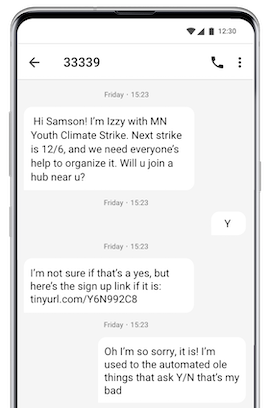Going beyond <first name> personalization
Hey –First Name=there–,
If I used your name, it’s because we have it in our email list from when you signed up for the product/newsletter.
You probably know that.
A name field in an email conveys about as much familiarity as Alexa kind of knowing how to pronounce your name. But you still clicked and started reading (woooh!). Let’s explore why:
Take the case of a peer-to-peer texting campaign.
Even if there is a real person handling conversations with contacts (and they follow all the peer-to-peer texting best practices), people still assume it’s an automated message.
72% of consumers only engage with marketing messages that are customized to their specific interests
The receiver in the example above replied to the text despite thinking it was automated—it was communication they had opted in for, and it was from a campaign they cared about. This brings us to what it means to personalize (calling, email, texting campaigns) beyond using a first name in your message:
- Your messages are going out to people who want to hear from you.
- You are talking about things they care about.
—
“I get a handful of push notifications on my phone every day. Problem is, I don’t remember signing up for them. It means most of the messages go ignored.”
Be sure to let your audience know exactly what they are signing up for when they opt-in.
Communicate what kind of messages you will be sending, and how often. Getting a buy-in is crucial if you want high engagement.
Ex.
There are cases where you don’t need explicit permission from contacts. Still, if you’re confident in the value of your messages, you can also be confident that they won’t refuse to opt-in.
Next, stay informed on your audience to know what interests them. This allows you to further personalize your messaging.
Political campaigns do this through “microtargeting” – Using the data they have on voters to inform how they communicate. Since most political campaigns don’t start from scratch when it comes to data, this is relatively easier for them. If you have no data at hand, you can inform your targeting by observing audience behaviour and/or talking to them directly.
Ex.
While your message doesn’t always have to be targeted towards the individual, it definitely needs to be targeted towards the individual’s interests.
See you next time,
Mukundan



